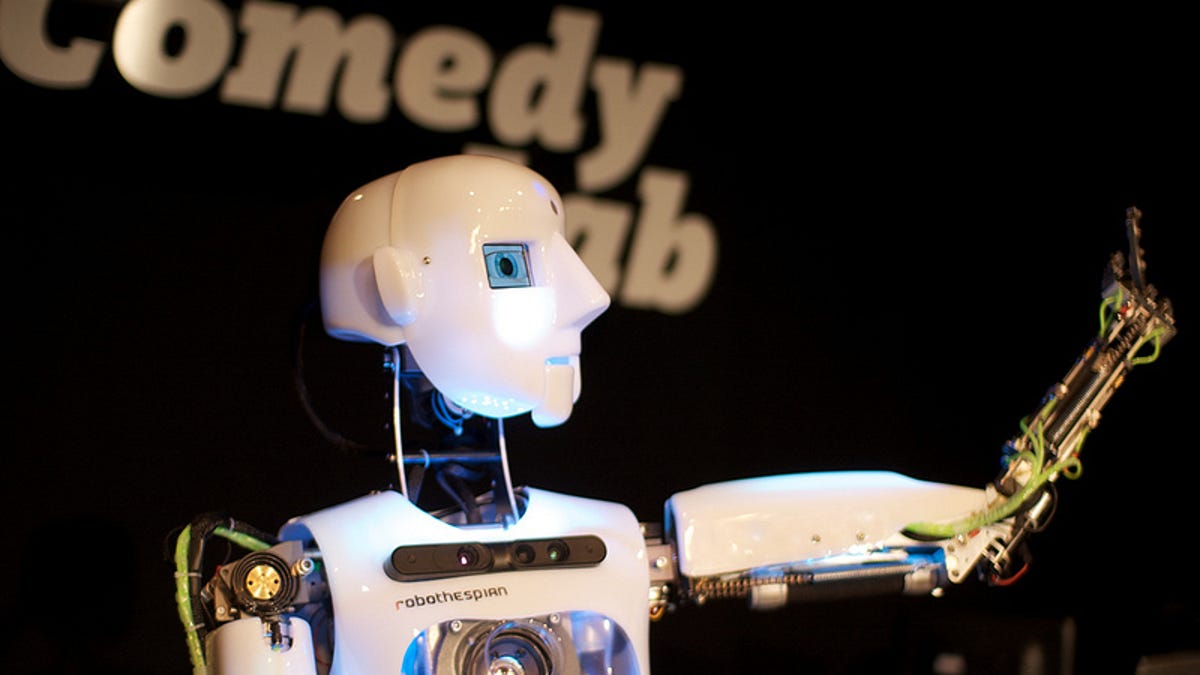RoboThespian tests its mettle as stand-up comic
Give it up for RoboThespian! The programmable bot takes the stage to crack jokes for humans -- and comes across a bit stiff.
Louis C.K. doesn't need to start worrying just yet. A new video of RoboThespian trying stand-up comedy suggests the humanoid bot's not quite ready for the Comedy Cellar.
"Hello, weak-skinned pathetic perishable humans; sorry, I mean ladies and gentlemen," the robot begins in a robotic male voice. (A few paltry laughs.)
"I never really know how to start, which is probably because I run off Windows 8."
"I once dated a MacBook. It didn't work because she was all 'i' this, and 'i' that."
"You know what really pushes my buttons? That guy that's in control of me."
OK, those went over a bit better at a performance at London's Barbican Centre last week.
Still, RoboThespian -- who can be controlled live or act out programmed skits from "Star Wars," Shakespeare, or just about anything else -- probably won't be gunning for a show on Comedy Central anytime soon.
Researchers from the Cognitive Science Research Group at Queen Mary University of London planned the performance to test whether a robot comedian could work the audience as well as a human.
RoboThespian took the stage alongside funnymen Andrew O'Neill and Tiernan Douieb, performing the same routine written by Douieb, with slight variations.
"We used computer vision and audio processing software to detect the response of each audience member simultaneously, something a human comic cannot do, noted Queen Mary Ph.D. candidate Kleomenis Katevas, who programmed the bot for the big event. "The machine used this information to determine who to look at and which gestures to use."
So how did the robo-comic stack up to its human counterparts? Being on the other side of the pond, we weren't able to attend the event, but New Scientist reporter Celeste Biever was, and she spotted a couple of potential comic advantages for RoboThespian, including being able to pull technical tricks like voicing recorded sound.
"Another of the robot's advantages is more surprising: because I feel less empathy for Robothespian than for the human comics, I feel more relaxed during his performance," Biever said. "When the humans take to the stage, there's an initial tension that grips me -- an intense hope that they won't disappoint -- and it's missing with Robothespian. Presumably that's because I won't feel awkward if a pile of metal flunks onstage."
RoboThespian, first created in 2005 by U.K. company Engineered Arts, is an interactive, customizable creature that can be programmed to communicate or entertain in a variety of ways. It follows robots like Mitsubishi's household bot Wakamaru and Kokoro's Actroid, both of which have done stints as comedians, models, and actors and have been available for rent as PR robots.
The Queen Mary researchers say they're most interested in how audiences can contribute to live performances. "This research will help us design more compelling live experiences and make technologies such as robots more entertaining and engaging," said Professor Pat Healey, leader of the university's Cognitive Science Research Group.
Let's start here: a robot walks into a Barbican Centre...


